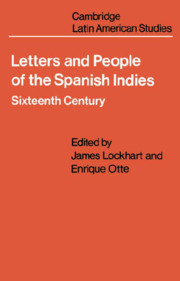Book contents
- Frontmatter
- Contents
- Preface
- Part I Conquest
- Part II The Variety of Life in the Indies
- 11 An encomendero's establishment
- 12 An encomendero's opinions
- 13 The miner
- 14 Commerce across the Atlantic
- 15 The professor of theology
- 16 The new arrival
- 17 The tanner and his wife
- 18 The troubadour
- 19 The nephew
- 20 The garden and the gate
- 21 The woman as settler
- 22 The farmer
- 23 The petty dealer
- 24 The Flemish tailors
- 25 The nobleman
- 26 The Hispanized Indian
- 27 Indian high society
- 28 An Indian town addresses the king
- Part III officials and Clerics
- Bibliography
- Index
21 - The woman as settler
from Part II - The Variety of Life in the Indies
Published online by Cambridge University Press: 06 August 2018
- Frontmatter
- Contents
- Preface
- Part I Conquest
- Part II The Variety of Life in the Indies
- 11 An encomendero's establishment
- 12 An encomendero's opinions
- 13 The miner
- 14 Commerce across the Atlantic
- 15 The professor of theology
- 16 The new arrival
- 17 The tanner and his wife
- 18 The troubadour
- 19 The nephew
- 20 The garden and the gate
- 21 The woman as settler
- 22 The farmer
- 23 The petty dealer
- 24 The Flemish tailors
- 25 The nobleman
- 26 The Hispanized Indian
- 27 Indian high society
- 28 An Indian town addresses the king
- Part III officials and Clerics
- Bibliography
- Index
Summary
Maria de Carranza, wife of a textile-mill owner, in Puebla, to her brother Hernando de Soto in Seville, 1589
… And buy four cured hams from Ronda …
We include this letter less for its idiosyncrasies than for its lack of them, that is, to emphasize that there were indeed Spanish women settlers, part and parcel of the general migratory movement, and sharing the general characteristics. They came from the same towns and regions of Spain as the men, because they were their wives, sisters and nieces, and they went to the same parts of the Indies. This means that they were most numerous in Mexico and Peru, like most of the other hallmarks of development in the sixteenth century, whether Spanish artisans, silver mines or black slaves. Without making them into culture goddesses as the Spaniards themselves sometimes did (see Letter 3), we can see the crucial role of women settlers in placing households in the cities under entirely Spanish management. Not every last household, certainly; but by the time of this letter, Spaniards of all social types down to the artisan level were tending to marry Spanish women, whether new from Spain or born in the Indies.
If we search in the present letter for anything that might be special to a woman, we might say that the list of foods to buy is even more detailed than Sebastian de Pliego's in Letter 18 (though quite similar), or that Maria de Carranza does show a special concern for gathering together all relatives, much as the stereotypes of the time dictated. For the rest, this is a standard recruitment letter, with the usual images, inducements, plans and expressions of annoyance at the reluctance of the stay-athomes. Most of it could have been written by any settler.
Desired and beloved brother of my heart:
I have never had a reply to the many letters I have written you, except one, and it gave me great joy to know of the health of yourself and my sister-in-law and my nephews, whom I hope our Lord someday lets me see, as I desire.
- Type
- Chapter
- Information
- Letters and People of the Spanish IndiesSixteenth Century, pp. 135 - 138Publisher: Cambridge University PressPrint publication year: 1976

